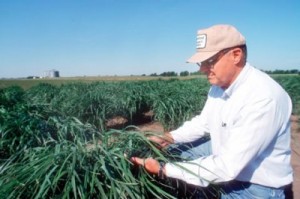New-And-Improved Biofuels: Report Predicts Cost-Competitive Cellulosic Ethanol By 2016
 Cellulosic ethanol is a biofuel produced from grass, wood chips, and other feedstocks that don’t double as food. So unlike traditional corn-based ethanol, it promises to avoid encroaching upon and destabilizing human food supplies — assuming it can become commercially viable. And according to a survey by Bloomberg New Energy Finance (BNEF), that time may come as soon as 2016.
Cellulosic ethanol is a biofuel produced from grass, wood chips, and other feedstocks that don’t double as food. So unlike traditional corn-based ethanol, it promises to avoid encroaching upon and destabilizing human food supplies — assuming it can become commercially viable. And according to a survey by Bloomberg New Energy Finance (BNEF), that time may come as soon as 2016.The report found that the costs of enzymes, pre-treatment, and fermentation in the production process have all fallen significantly, and as a result the cellulosic biofuel industry expects its product to be cost competitive with corn-based ethanol and gasoline by 2016. But more ground needs to be covered if that goal is to be achieved. In 2012, cellulosic ethanol production cost $0.94 per litre, compared to the $0.67 per litre cost of corn-based ethanol — which is already competitive with gasoline.
So it’s understandable that Harry Boyle, the lead biofuel analyst at BNEF, is advising caution: “The cellulosic ethanol industry has something of a history of over-promising cost reductions and under-delivering. However, it may be dangerous to assume that it will not become competitive this decade.” And the report found several reasons to think the survey’s prediction might pan out:
The survey found that the largest cost elements for producers in 2012 were project capital expenditure, feedstock and enzymes. The operating costs of the process have dropped significantly since 2008 due to leaps forward in the technology. For example, the enzyme cost for a litre of cellulosic ethanol has come down 72 percent between 2008 and 2012.
Improvements in running costs for cellulosic ethanol plants will turn the spotlight squarely onto capital costs, which survey respondents expected to make up fully 45 percent of the overall expense of manufacturing a litre of cellulosic ethanol by 2016 — with feedstock contributing a further 34 percent. Developers will have to find ways of reducing the initial outlay on the plant, and reducing risk to attract cheaper financing. Boyle said: “We expect therefore to see a shift in focus over the next five to 10 years — from technology enhancements to logistical planning — that in turn suggests the industry is maturing.”
Globally, there are 14 enzymatic hydrolysis pilots; nine demonstration-stage undertakings; and 10 semi-commercial scale plants either announced, commissioned, or due online shortly. Five of the semi-commercial facilities are located in the US, but a swing towards Brazil is expected in the near future, with two announced there so far. Bloomberg New Energy Finance defines a semi-commercial facility as having capacity of 90 million litres per year, requiring an initial outlay of approximately $290 million. By 2016 the second and third tranche of plants will be reaching commissioning, with annual capacities ranging from 90 to 125 million litres. The initial outlay per installed litre is expected to fall from the original $3, to $2, due to economies of scale and a reduction in over-engineering.
If this report proves accurate, it could be a game-changer for biofuels and their role in the climate change solutions mix, given the problems that have so far bedeviled the energy source.
The requirements set by both the United States and Europe that a certain portion of their fuel supply come from biofuels have so far resulted in a huge diversion of corn crops away from use as food and into biofuel production. The increased demand for biofuels also drives farmers to dedicate land that could be used for food to biofuel feedstock production. The resulting spike in food prices and destabilization of food supplies has been disastrous for the populations of many poorer and developing countries around the globe. Most assessments of the 2008 food crisis found that biofuels played a role, compounding the threat of greater food insecurity already posed by climate change — which can in turn ferment geopolitical insecurity and destabilization.
On top of all this, corn-based biofuel use drives the conversion of grasslands and forest into cropland, even though the former two actually do much more to reduce carbon in the atmosphere than the latter. Combine that with the carbon emissions from increased agricultural production, and corn-based biofuel actually negates most, if not all, of its carbon-reducing benefits.
You can return to the main Market News page, or press the Back button on your browser.

